Europe Payments Market Size
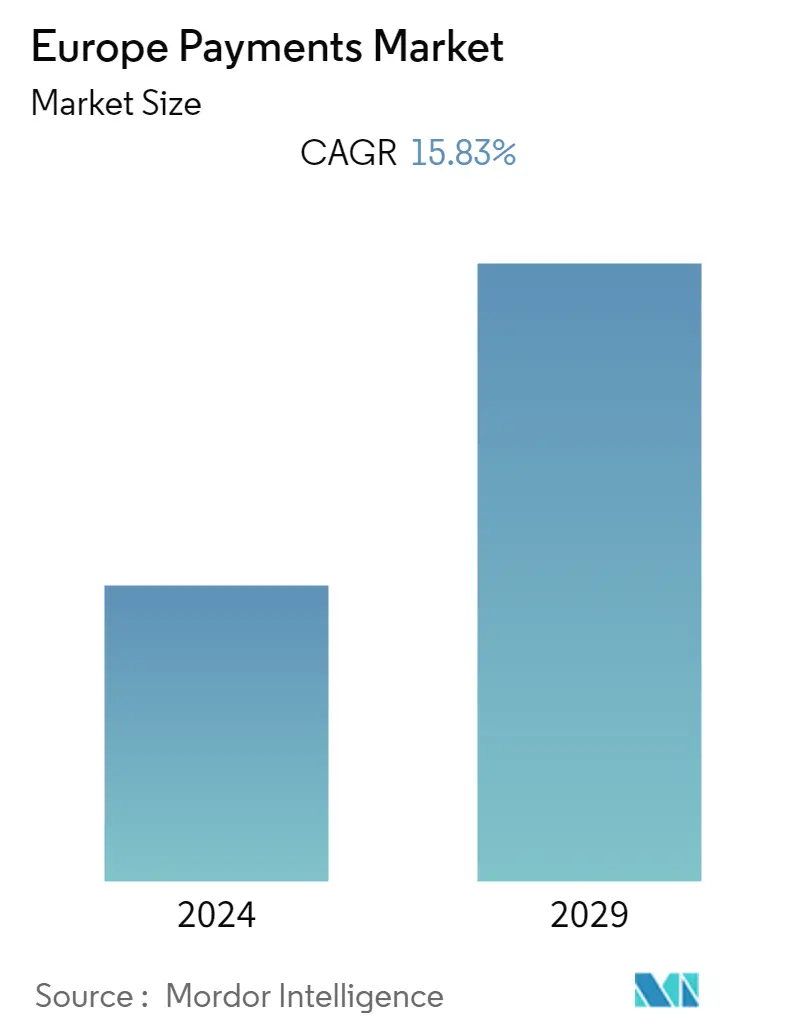
| Study Period | 2019 - 2029 |
| Base Year For Estimation | 2023 |
| Forecast Data Period | 2024 - 2029 |
| Historical Data Period | 2019 - 2022 |
| CAGR | 15.83 % |
| Market Concentration | Medium |
Major Players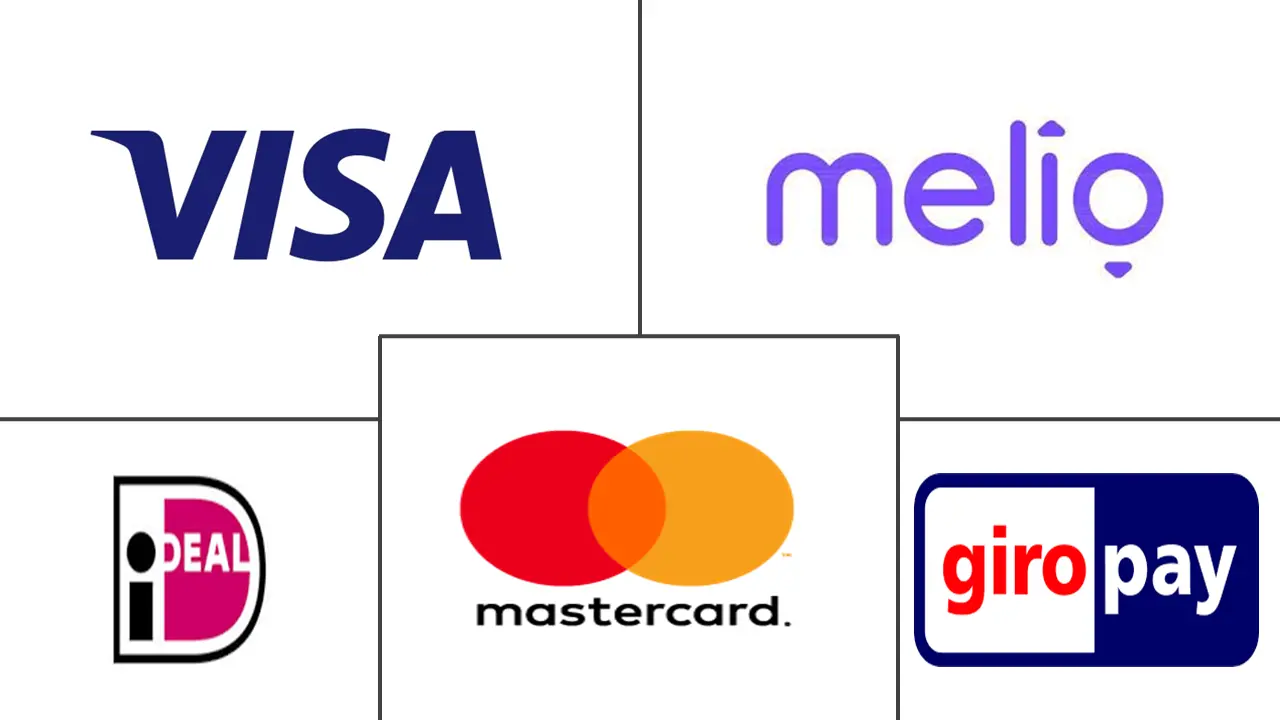
*Disclaimer: Major Players sorted in no particular order |
Europe Payments Market Analysis
The European payments market is expected to grow at a CAGR of 15.83% over the forecast period (2022 - 2027). Digital wallets are reshaping the European payments market. European digital and mobile payment transaction value has increased by more than 30% in the last three years. These payment methods are becoming increasingly popular today and by 2023.
- In the European market, providers of cashless applications and digital wallet services, such as Apple pay, keep payments secure by combining tokenization with biometric features. When the payment card is activated, it receives a one-of-a-kind virtual token. This number is encrypted and securely stored on the user's mobile device. Only a biometric identification feature allows access to the token.
- Making cross-border payments is a necessity for many European businesses and consumers. Traditional banks have traditionally controlled cross-border payments in Europe, as in many other geographies. On the other hand, traditional banks have been slow to respond to customers' changing needs for embedded FX solutions. Wise (formerly TransferWise) and Currencycloud are two new players that have emerged to capitalize on these opportunities (both Sapphire investments).
- BNPL payment methods are becoming more popular in the European market. Klarna is the most prominent global payments service, offering 147 million active consumers in 45 countries more innovative and flexible shopping and purchasing experiences. BNPL payment methods will likely face regulatory challenges, limiting their service growth. Their popularity, however, cannot be denied. BNPL systems charge installments for the users until the total amount is paid.
- The international digital payments industry has been profoundly altered by the COVID-19 global health crisis in the European market in 2020, which has resulted in significant market advancement since then. The adoption of contactless payments has increased consistently and is expected to accelerate further. Indeed, global cashless transactions are expected to grow at an annualized rate of about 18% between 2020 and 2025.
- The pandemic facilitated the transition from traditional to digital banking. As many customers turned to internet shopping for the first time in Europe, ATM withdrawals fell, and geographic and age group differences in purchase behavior were significantly reduced. Between January and May 2020, Switzerland noted an increase in the share of debit-card spending from 65 % to 72 %.
Europe Payments Market Trends
This section covers the major market trends shaping the Europe Payments Market according to our research experts:
Increasing use of Digital wallets while shopping online
- With changes in customer preference for electronic payments, a desire for easier cross-border transactions, and the upcoming launch of the official European Digital Authenticity Wallet, digital wallets are rising in Europe. It is a temporary fix until digital and mobile wallets overtake traditional online payment methods in Europe.
- The wallet of choice for millions of European digital wallet users differs significantly by country. Russia prefers YooMoney (formerly Yandex. Money), and Qiwi, the Netherlands prefers iDEAL, and in Germany, 70% of consumers use PayPal, while Sweden likes Klarna and Swish. Even before the pandemic, digital payments were so popular in Sweden that only 13% of Swedes paid cash for their latest in-person purchase.
- Digital wallets have been identified as a critical payment method for e-commerce transactions in the European market. They can help relieve consumer concerns about sharing card details with merchants directly. Digital wallets have been quickly adopted by advanced e-commerce economies such as the United Kingdom and Germany, but smaller e-commerce markets embrace this payment method.
- PSD2, the European directive governing payment services, is a crucial pillar of payment and identity advancement. It combines the two into a single service and boosts consumer confidence, facilitating the adoption of online payment methods and online identity services.
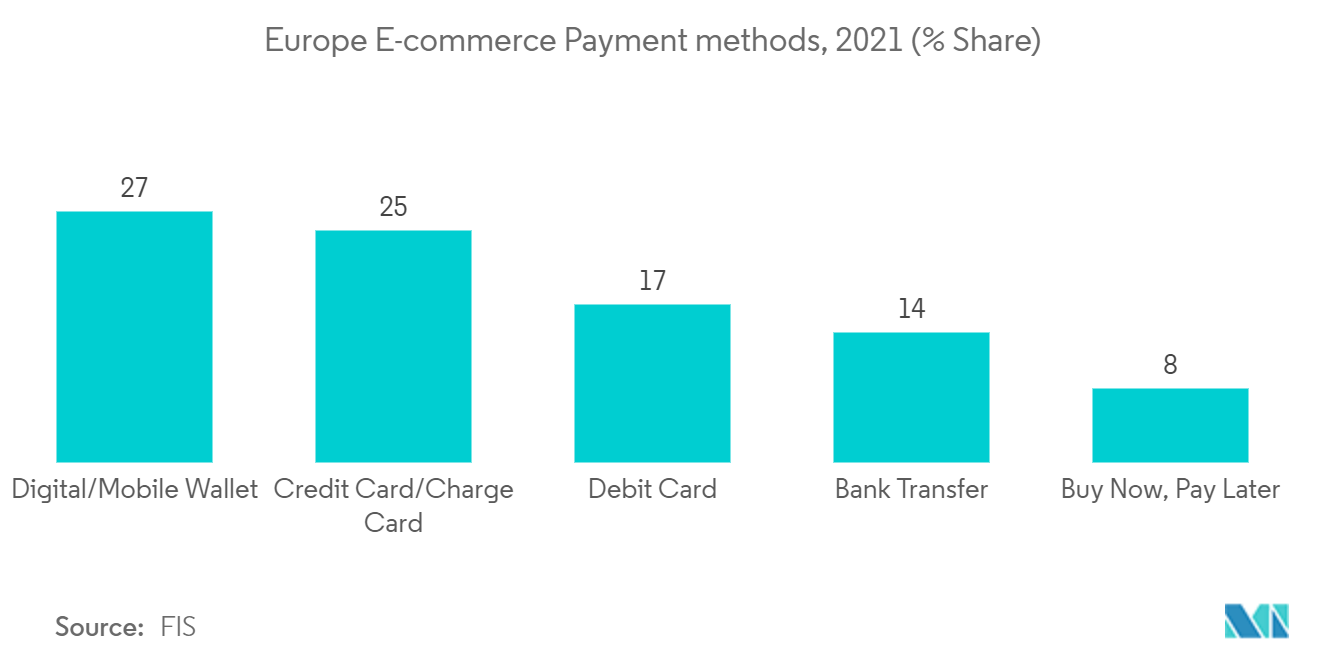
Growth in usage of mobile device
- European countries like Czechia, the United Kingdom, Ireland, Sweden, and many more spent more time on computers, tablets, and mobile devices. Almost every region spent more time online on mobile devices. As mobile internet usage grows, global spending on the Google Play and Apple App Stores increases year after year. Overall, demand for the App Store is expected to be more than double that of Google Play.
- When it comes to online buying, cards continue to be a key payment method in the majority of European markets. Card use is especially prevalent in wealthy, technologically advanced countries with the highest bank penetration. Card payments are currently highest in Denmark (63.4% of e-commerce payments), Ireland (60%), and the United Kingdom (53%).
- Most Europeans are increasingly considering and adopting e-wallets as their preferred payment method because they provide a much more convenient way to receive and send money, whether they are purchasing something from a store or paying online. E-wallets have also allowed businesses to accept alternative forms of payment, such as cryptocurrencies or foreign currency. This dominance is expected to grow further, with e-wallets accounting for up to 30% of e-commerce transactions in Europe by 2024.
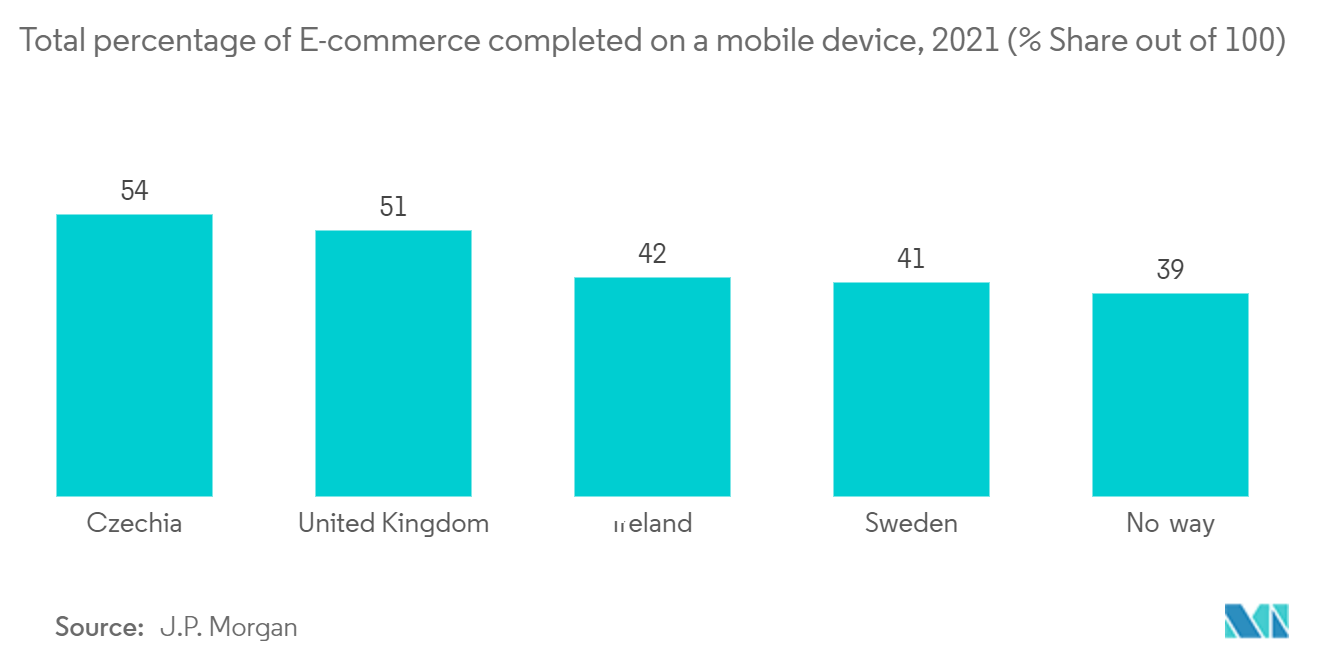
Europe Payments Industry Overview
Paypal dominates the digital wallet market, as it does in other large European markets. The European payments market is becoming more competitive, with new entrants such as Google Pay, Apple Pay, and Amazon Pay showing significant challenges. Furthermore, in almost every European country, PayPal and Visa are the most popular payment methods for online shopping.
- May 2022- Melio enables small business owners to pay all vendor bills with credit cards. It has given small business owners more options for paying bills. Melio's user-friendly payments system consolidates all of a company's accounts into a single interface. Business owners can pay specific bills and vendors directly from the app.
- December 2021- AS Roma, an Italian professional football club based in Rome, partnered with REPX, a British fintech firm, to launch a new innovative prepaid card for Giallorossi fans. Users of the prepaid card will be able to transfer money between supporters instantly and without charge.
Europe Payments Market Leaders
-
Visa Inc.
-
Mastercard
-
Currence iDEAL BV
-
Paydirekt GmbH (Giropay)
-
Melio Payments Inc.
*Disclaimer: Major Players sorted in no particular order
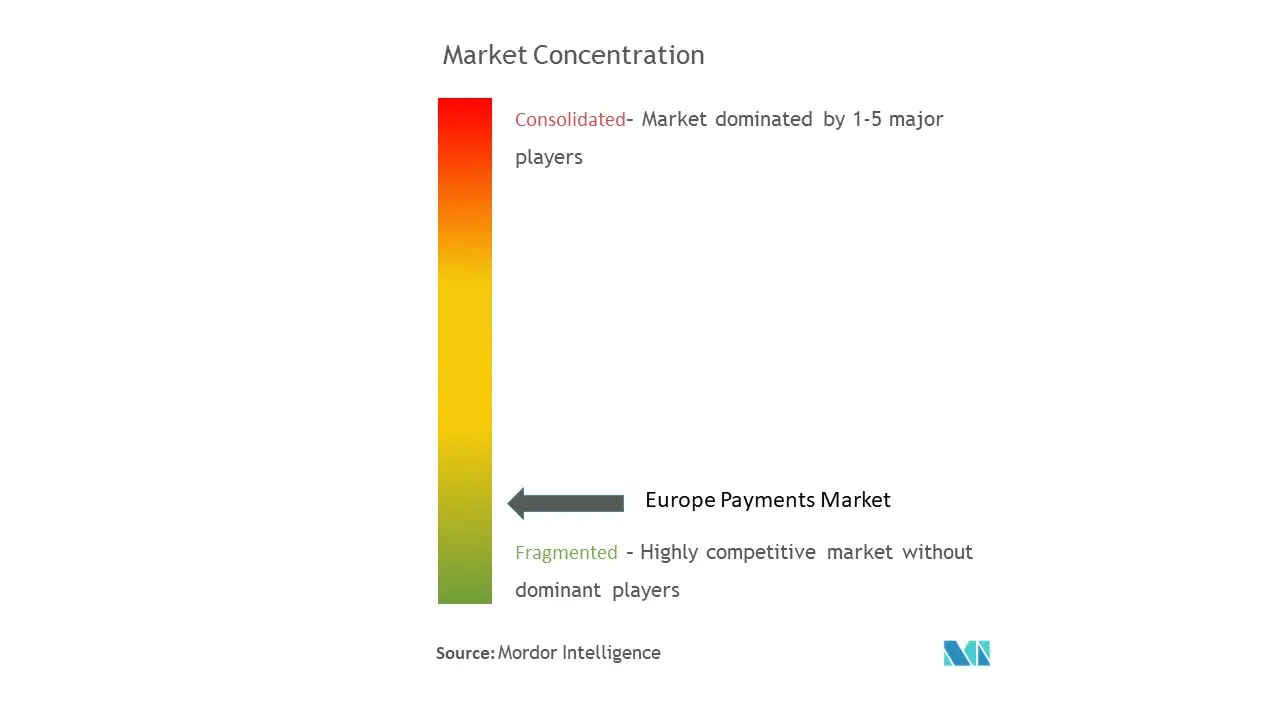
Europe Payments Market News
- May 2022- The European Union's antitrust regulator has accused Apple of restricting rivals' access to its payment technology, forcing the company to change its business practices and expose it to a massive fine.
- May 2022- The Thames Technology Fusion Card will be the first metal card with a dual interface manufactured in Europe, according to the company's website.
- May 2022- PingPong Payments, a Chinese cross-border payments platform, is partnering with European bank BNP Paribas to acquire services for Europe's direct-to-consumer (D2C) market.
- May 2022- Platform for payments Paysafe is expanding its partnership with Visa to continue integrating the real-time push payment processing solution Visa Direct. Paysafe provides Visa Direct to merchants, exchanges, operators, and other online businesses in the United Kingdom and Europe when the speed of settlement is critical, such as in forex trading, cryptocurrency, or online gaming.
Europe Payments Market Report - Table of Contents
1. INTRODUCTION
- 1.1 Study Assumptions and Market Definitions
- 1.2 Scope of the Study
2. RESEARCH METHODOLOGY
3. EXECUTIVE SUMMARY
4. MARKET INSIGHTS
- 4.1 Market Overview
- 4.2 Industry Stakeholder Analysis
-
4.3 Industry Attractiveness-Porter's Five Forces Analysis
- 4.3.1 Bargaining Power of Suppliers
- 4.3.2 Bargaining Power of Buyers/Consumers
- 4.3.3 Threat of New Entrants
- 4.3.4 Threat of Substitute Products
- 4.3.5 Intensity of Competitive Rivalry
- 4.4 Evolution of the payments landscape in the Region Europe
- 4.5 Key market trends pertaining to the growth of cashless transaction in the Region Europe
- 4.6 Impact of COVID-19 on the payments market in the Region Europe
5. MARKET DYNAMICS
-
5.1 Market Drivers
- 5.1.1 Increased digitalisation and decreased cash usage and Real-Time Payments
- 5.1.2 The digital economy's expansion and changing consumer behaviour
- 5.1.3 Regulation, specifically PSD2 and Open Banking
-
5.2 Market Challenges
- 5.2.1 Infrastructure for alternative payment methods
-
5.3 Market Opportunities
- 5.3.1 PSD2 and Open Banking have created multiple great possibilities for consumers and businesses alike.
- 5.3.2 The success of older online payment services such as Klarna, Affirm, and Afterpay has paved the way for newer entrants such as Scalapay and Alma.
- 5.4 Key Regulations and Standards in the Digital Payments Industry
- 5.5 Analysis of major case studies and use-cases
- 5.6 Analysis of key demographic trends and patterns related to payments industry in the Region Europe (Coverage to include Population, Internet Penetration, Banking Penetration/Unbanking Population, Age & Income etc.)
- 5.7 Analysis of the increasing emphasis on customer satisfaction and convergence of global trends in the Region Europe
- 5.8 Analysis of cash displacement and rise of contactless payment modes in the Region Europe
6. Market Segmentation
-
6.1 By Mode of Payment
- 6.1.1 Point of Sale
- 6.1.1.1 Card Payments (includes Debit Cards, Credit Cards, Bank Financing Prepaid Cards)
- 6.1.1.2 Digital Wallet (includes Mobile Wallets)
- 6.1.1.3 Cash
- 6.1.1.4 Others
- 6.1.2 Online Sale
- 6.1.2.1 Card Payments (includes Debit Cards, Credit Cards, Bank Financing Prepaid Cards)
- 6.1.2.2 Digital Wallet (includes Mobile Wallets)
- 6.1.2.3 Others (includes Cash on Delivery, Bank Transfer, and Buy Now, Pay Later)
-
6.2 By End-user Industry
- 6.2.1 Retail
- 6.2.2 Entertainment
- 6.2.3 Healthcare
- 6.2.4 Hospitality
- 6.2.5 Other End-user Industries
-
6.3 By Country
- 6.3.1 United Kingdom
- 6.3.2 Germany
- 6.3.3 France
- 6.3.4 Spain
- 6.3.5 Italy
- 6.3.6 Nordics
- 6.3.7 Rest of Europe (Eastern Europe, Benelux, etc.)
7. Competitive Landscape
-
7.1 Company Profiles
- 7.1.1 Visa Inc.
- 7.1.2 Mastercard
- 7.1.3 iDEAL
- 7.1.4 Giropay
- 7.1.5 Bancontact
- 7.1.6 Melio Payments
- 7.1.7 PayPal Holdings Inc.
- 7.1.8 SEPA Direct Debit
- 7.1.9 Multibanco
- 7.1.10 Klarna
- *List Not Exhaustive
8. Investment Analysis
9. Future Outlook of the Market
** Subject To AvailablityEurope Payments Industry Segmentation
Payments are increasingly becoming cashless, and the industry's role in fostering inclusion has become a top priority. Payments contribute to developing digital economies and drive innovation, all while serving as a stable backbone around the world.
The Europe Payments Market is Segmented by Mode of Payment (Point of Sale (Card Payments, Digital Wallet, Cash), Online Sale (Card Payments, Digital Wallet)), by End-user Industries (Retail, Entertainment, Healthcare, Hospitality), and by Country.
| By Mode of Payment | Point of Sale | Card Payments (includes Debit Cards, Credit Cards, Bank Financing Prepaid Cards) |
| Digital Wallet (includes Mobile Wallets) | ||
| Cash | ||
| Others | ||
| By Mode of Payment | Online Sale | Card Payments (includes Debit Cards, Credit Cards, Bank Financing Prepaid Cards) |
| Digital Wallet (includes Mobile Wallets) | ||
| Others (includes Cash on Delivery, Bank Transfer, and Buy Now, Pay Later) | ||
| By End-user Industry | Retail | |
| Entertainment | ||
| Healthcare | ||
| Hospitality | ||
| Other End-user Industries | ||
| By Country | United Kingdom | |
| Germany | ||
| France | ||
| Spain | ||
| Italy | ||
| Nordics | ||
| Rest of Europe (Eastern Europe, Benelux, etc.) |
Europe Payments Market Research FAQs
What is the current Europe Payments Market size?
The Europe Payments Market is projected to register a CAGR of 15.83% during the forecast period (2024-2029)
Who are the key players in Europe Payments Market?
Visa Inc. , Mastercard , Currence iDEAL BV, Paydirekt GmbH (Giropay) and Melio Payments Inc. are the major companies operating in the Europe Payments Market.
What years does this Europe Payments Market cover?
The report covers the Europe Payments Market historical market size for years: 2019, 2020, 2021, 2022 and 2023. The report also forecasts the Europe Payments Market size for years: 2024, 2025, 2026, 2027, 2028 and 2029.
Payments in Europe Industry Report
Statistics for the 2024 Payments in Europe market share, size and revenue growth rate, created by Mordor Intelligence™ Industry Reports. Payments in Europe analysis includes a market forecast outlook 2029 and historical overview. Get a sample of this industry analysis as a free report PDF download.



